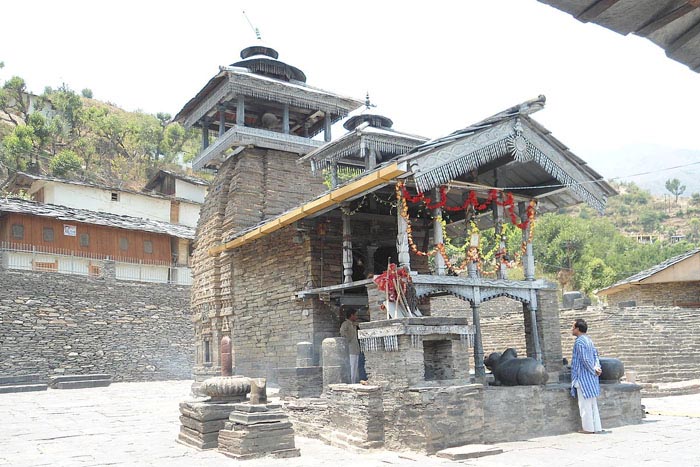Lakha Mandal Temple

Information of Lakha Mandal Temple, Dehradun, Uttarakhand
Lakha Mandal Temple is an historic site and an ancient Hindu temple built for Lord Shivha. This Lakha Mandal is also called the Dev Bhoomi of the Deharadun. It is beautifully located in between the holy rivers like the Yamuna and Gomti. This temple is maintained by the Archeological department of India and it has a special gallery of sculptors and other stone articles in display which were found by many excavation works undergone in these valleys. This is the best place to see one of the ancient temples of Hindus and its unique architecture scattered all around this valley of temples. These temples are seen in the plain land surrounded by huge mountain valleys and look very scenic. It is divinely located at Lakha Mandal, Marda Village, Dehradun District of Uttarakhand State in India.
Lakha Mandal Temple Religious Significance
Lord Shiva is the main deity in the Linga form here. The specialty of this temple is its historical importance, since it was a land of Lakhs of temples or the Valley of Hindu temples on the Himalayas. This is the only temple to have a huge graphite Linga which has a property of a glittering nature when water is poured on it. Here the main deity or the Shiva Linga is covered by the hood of a giant 10 head serpent. It also has the sculptor of Maha Kalashwer behind the Linga. This temple was once a great place to do rituals for the deceased peoples of Hindus. But this ritual is stopped in the temple premises and a special pooja can be done on the August month's new moon day, which is the day for paying homage for the deceased. Visiting ancient temples are very powerful according to the Hinduism, as such many pilgrims going to Panch Kedar temple visit also come here and worship. Near this temple a cave is found, it is believed that the Lord Karthikeya was born here.
Festival at Lakha Mandal Temple
The Bisu Mela is held on 12th April of every year. It is a grand Lakha Mandal Temple festival organized by its local tribes named the Jaunsari. The festival is celebrated with many cultural activities within the temple complexes. The Shivarathri and Navami are also celebrated here with special rituals.
Lakha Mandal Temple Mythology & History
The creators of this Dev Bhoomi or the land of Gods were done by the Pandavas of the Mahabharata times. There are many mythic stories related to the Mahabharata legends behind the creation of this temple. It was said that the Kauravas planned to burn the Pandavas alive in this area when they were in exile in the Himalayas. But they timely escaped from them and hide them self in a nearby cave. They initially build this Shiva Linga since they meditated here. Since then it became a famous Hindu worship place and was once went under the earth due to a massive landslide happened here in the ancient times. Recent excavation showed that it was an important site of the Mahabharata Epic.
Lakha Mandal Temple Architectural Significance
Lakhamandal was once destroyed by a major landslide and remained under the mud for thousands of years. The main Shiva temple was brought out under the Gupta Dynasty in between 8-15 century AD. Once again many temples were excavated under the British India rule 300 years ago. It was noted that these were remained under the lands for thousands of year back. Nearly lakhs of temple where here in a 5 square kilometer area, that why it was called Lakha Mandal. Still excavation is going on by the archeological survey of India and the Lakhamandal is declared as ancient monuments by government of India. These temples were found in the Huna architectural pattern. The entire temple is made out of granite stones. The main temple is a huge tower with a small wooden made porch on its top. The entrance of the temple is found with a big porch. In front of the temple one can find two Nandhi idols facing towards the main temple. The presiding deity is Lord Shiva in the Linga form. It is seen with a brass made serpent covering with its hood over the Linga. The walls inside the sanctum sanctorum have many sculptors and the main sculptor is Maha Kalashwar seen just back side of the Shivalinga. All around the temple grounds one can find many Shiva Linga scattered around. This is the only temple to have graphite made huge Shivalinga which shines when water is poured on it. There are two door mans of lord Vishnu known an s the Dhanav and the Manav at the backside of this temple. There are also many stone arts and sculptors depicting the stories of the Tretha Yuga and Kali Yuga. All these sculptors and are very beautiful and can't be compared with any other parts of this sub continent.
- Andhra Pradesh Temples
- Assam Temples
- Bihar Temples
- New Delhi Temples
- Goa Temples
- Gujarat Temples
- Jammu and Kashmir Temples
- Karnataka Temples
- Kerala Temples
- Madhya Pradesh Temples
- Maharashtra Temples
- Odisha Temples
- Punjab Temples
- Rajasthan Temples
- Sikkim Temples
- Tamil Nadu Temples
- Telangana Temples
- Uttar Pradesh Temples
- Uttarakhand Temples
- West Bengal Temples